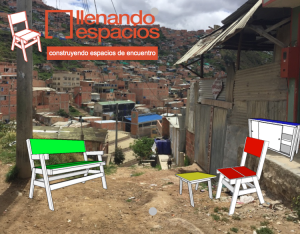David Pye contrasts what he calls workmanship of risk, in which throughout the process of making, the final piece is in danger, with workmanship of certainty in which the outcome of the piece is guaranteed. Workmanship of risk is generally applied to crafts while workmanship of certainty is to mass production.
Over the last few years I have conducted workshops with volunteers without any experience whatsoever, building furniture for low income families and transforming small spaces. Furniture tells us how it wants to be used, teaches us how to live in our spaces -for better or worse- and sends a message about the kind of spaces and lives we believe we are entitled to. In “Welcome to your World,” Sarah Williams Goldhagen talks about the importance of good design in big architectural spaces, but what she says can also be applied to people’s rooms.
Every workshop begins similarly. I have to reassure everybody that they are capable of doing the work. Concern arises from the little to null experience that we have in building the objects that surround us. Not many of us have a direct connection with the process of making. Usually somebody else builds our house, the furniture that we use is bought at a store and we´ve become increasingly used to complex electro domestics. We have gotten used to being surrounded by the workmanship of certainty and the polished objects that it usually produces. Even the tools that some of us use for the workmanship of risk are really complex. Looking at any tool catalog you´d be excused if you closed it convinced that you needed a tool in the hundreds of dollars to measure up to microns of a, not always needed, precision. Their goal (even when they do help you), is to sell you tools that you don’t necessarily need. It’s easy to become intimidated, but building can be much simpler and accessible.
When well-designed buildings and designer chairs surround you, but you lack access to them, there’s a risk that you convince yourself that quality spaces are not for you and get used to low quality surroundings. If public infrastructure is non-existent in your neighborhood, your private surroundings tend to reflect that. That you can be an active participant in building and improving them, doesn’t cross your mind. When we are spectators in the construction of our spaces, when the quality of those spaces comes from outside, it’s easy to get used to accepting whatever comes. Learned helplessness has to be unlearned.
For Karl Popper, “all life is problem solving”, but we have gotten used to outside solutions. Used to believing that we cannot solve our spaces. If we want to build Infrastructures of Inclusion, we have to create the mindset to make them possible. We can learn to be problem solvers while building our surroundings. We don’t have to wait for big perfect projects. We can imperfectly work to improve our small private spaces and if we help each other and do it together, maybe build a community. Doing so, can help us to become more than just visitors in our own neighborhoods.
: :
